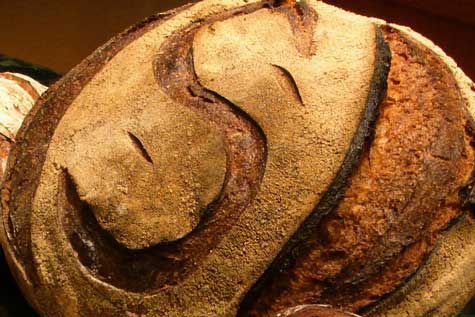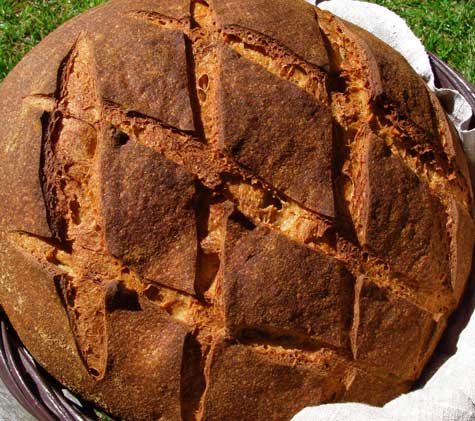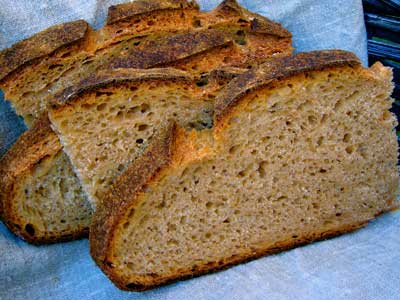A few days ago I brought one of these miches to dinner at the home of people I’d never met before. In retrospect, this was one of those “what was I thinking?” ideas, because it could have been awkward if they had turned out to be bread wimps. Luckily, they weren’t, or they were very gracious about hiding it. Huge and chewy and sour, with a crust so dark it might be mistaken for burned by the uninformed, this miche is some serious bread.
I’ve had trouble pinning down the exact definition of “miche” (French slang for “butt-cheek,” according to Daniel Leader’s Local Breads). I believe that nominally it is a large, round, somewhat flattened loaf, but beyond that it seems that most breads that call themselves miches involve sourdough and a substantial proportion of whole-grain or high-extraction flour.
For this miche, I used Golden Buffalo, a high-extraction flour from Heartland Mill. White flour is milled from the inner endosperm of the wheat kernel. In contrast, high-extraction flours contain some of the bran and/or germ of the wheat, but not necessarily all of it (that would be whole wheat flour). A reasonable improvisation for the high-extraction flour in this recipe would be to get some coarse whole wheat flour and sift it to remove the large bran particles.
While this bread looks like it takes more than a day-and-a-half to make, most of that is simply building up the levain (sourdough), which requires no more than a brief mixing of ingredients. This bread is a little unusual in that the final dough contains a large proportion of levain, compensated with a short first fermentation. And notice that the building of the levain includes the somewhat atypical addition of salt. Because the fermentation time of the levain is quite long, the salt slows the yeast down a bit and helps prevent over-fermenting.
You’ll need a 10- or 11-inch bowl or basket for this. A colander, salad bowl, or shallow mixing bowl lined with linen or a non-terry cotton towel are all fine candidates if you don’t have a large banneton.
 For the miche pictured above, I used very little flour for dusting the linen lining the bowl. A heavier dusting will produce something more like this, which is also very handsome. (Photo from my Advanced Breads course at SFBI, from which this recipe is adapted.) The diamond scoring pattern is traditional, but you can do an initial, or anything else that strikes you.
For the miche pictured above, I used very little flour for dusting the linen lining the bowl. A heavier dusting will produce something more like this, which is also very handsome. (Photo from my Advanced Breads course at SFBI, from which this recipe is adapted.) The diamond scoring pattern is traditional, but you can do an initial, or anything else that strikes you.
High-Extraction Miche
Yield: 1800 g (one large loaf)
Time:
- Mix and ferment levain (first feeding): 16 hours
- Mix and ferment levain (final build): 8 hours
- Mix final dough: 30 minutes
- First fermentation: 45 minutes
- Divide and shape: 5 minutes
- Proof: 2.25 hours at room temperature, then 12 hours in the refrigerator
- Bake: 1 hour
Desired dough temperature: 76F
Levain (first feeding) ingredients:
- 80 g high-extraction flour (I used Heartland Mill Golden Buffalo)
- 96 g water at about 70F
- 0.5 g salt (1/16 t.)
- 8 g ripe 100%-hydration sourdough starter
Levain (final build) ingredients:
- 462 g high-extraction flour
- 554 g water at about 70F
- 2.8 g salt (1/2 t.)
- all of the levain from the first feeding
Final Dough Ingredients:
- 314 g white flour
- 105 g high-extraction flour
- 105 g whole rye flour
- 95 g cool water (about 50F)
- 20 g salt
- All of the levain from the final build
Method:
- In a small bowl, mix the levain (first feeding) ingredients until just combined. Cover the bowl and let the levain ferment at room temperature for 16 hours.
- In a large container, mix the levain (final build) ingredients until just combined. Cover the container and let the levain ferment at room temperature for 8 hours.
- Mix the final dough ingredients in a stand mixer on low speed until the ingredients are well incorporated, about 4 or 5 minutes. Use enough water so that the dough has a medium consistency.
- Cover the dough with a towel and let it rest for 15 minutes.
- Continue mixing on low speed until the dough reaches a low-medium level of gluten development. This might take 4 or 5 minutes, but will depend on your mixer.
- Transfer the dough to a well-oiled container.
- Ferment at room temperature for 45 minutes.
- Shape the dough into a tight ball and place it, seam side up, into a large linen-lined, flour-dusted bowl or basket. Press the dough to flatten the ball a little.
- Slip the bowl into a large plastic bag, or otherwise cover it.
- Proof for about 2 hours and 15 minutes at room temperature, or until the loaf seems not quite fully proofed. Then refrigerate it for 12 hours.
- Preheat the oven, with baking stone, to 425F. You will also need steam during the initial phase of baking, so prepare for this now.
- Remove the miche from the refrigerator about 45 minutes before baking.
- Just before baking, score the miche as you like.
- Bake for 10 minutes with steam, and another 35 minutes or so without steam. The crust should be a very dark brown. Then turn off the oven and leave the loaf in for another 15 minutes, with the oven door ajar.
- Cool on a wire rack. Wait until completely cool to cut and eat. This will take several hours.



Excellent site. Found you in the comments of another site! I love your comment about “bread wimps!” Can’t wait to check out your recipes.
Funny Saturday I interviewed Dan as well I made some olive levain and on Sunday I made the high extraction, I was lucky to have some left over flour I brought back from Switzerland!!
Jeremy
I have said it before – you’re truly amazing! I hope to make it to your level some day.
I am definitely using your phrase “bread wimps” in conversation later 🙂
Amazing.
~Lewis
TableBread
Good Lord girl! Just when I think it’s safe to lift my head! What incredible bread!!!!!! Listen well Susan, WRITE THE BOOK soon! I will buy it. 😀
You are incredibly talented.
BZ
That’s my idea of bread. Will definitely try this one out. I do have some Golden Buffalo, which is one of my favorite flours. Also, recently purchased a grain mill and was planning on trying to use a fine screened tamis to sift out the bran. This one may be for next weekend’s bake. I know these are typically baked in large loaves, but do you think it could be baked in two smaller loaves? Le Pain Susan!
Liz
Susan
Your miche is great. I placed an order for the Golden Buffalo flour a few day ago, will try your recipe. I also have same question as Liz, can I baked them into two smaller loaves? Thanks
Hi Kellypea, thanks and welcome!
Jeremy, I enjoyed listening to your interview with Daniel Leader. I’ll bet the Swiss flour made excellent bread.
Lewis, you are very kind. Thank you for reading.
BZ, no book in my immediate future but I’m truly honored and happy that you enjoy my blog.
Liz and Kim, mini-miche, yes of course. Since you will need to bake smaller loaves for a shorter time, you might want a little higher temperature to make sure you get the crust nice and dark.
Made the Miche over the last couple of days and it turned out great. My newly adapted frigid weather starter technique seems to be working well. Thank you for the suggestions. Have you had much experience with Spelt Flour?
Dan, I’ve no experience to speak of with spelt. It’s something I’m meaning to experiment with. I’m glad the miche turned out well!
In proper French it means “large round bread”, in slang it means “butt” or “bum”. Nice!
Anyway, I will try out your checkered butt replacing the high-extraction with T110. I use it a lot because it gives a wonderful taste and texture to bread. I haven’t tried a “levain bread” with these types of builds. I’ve been scared off them because of a couple of breads I did on a three day timing that turned out not that great. I found the flavor was lost. Strange! But, I will try again!! I’ll let you know.
Jane
Just made the miche from Golden Buffalo and got great rise and taste. I had to leave it in oven for about one hour. I now see that your pictures show thicker and darker crust. Do you think I should increase baking temp (450) or increase time (the interior temp was perfect 205)? Thanks for posting this recipe.
Highheat, for lean breads such as this, 210F is a good temperature to shoot for. And even when it reaches that, try leaving it to bake longer if the crust does not seem done; it is very difficult to overbake bread!
I think the word we’re all looking for is “rump.” That too is used in English to signify similarly shaped objects. What do you think?
I myself love miche. I wish more people around me did as well, but I can really go through the stuff. Usually I just adapt a rough 1, 2, 3 approach to levain (50%), water, and flour respectively, with at least 50 % WW. I will have to look into the HM flours…
Sorry to chatter on, but I assume the extra stages with the levain are for pungency?
Hi Susan. What if we have 125% starters? How do we adjust recipes up/down that require different starter hydration percentages? Thanks!
Hello,
I have visiting Germany for 40 years with my wife. Of the things I miss most when I am here at home is the German “Landbrot” or “Bauernbrot”. I have a baker uncle there who I asked once for a recipe and the only things he could give me were the type of special wheat flour required (type 405?) and a recipe that wasn’t possible because of the 50 kilo bags of flour and the scaling of ingredients. I have been on a quest for a recipe for many years since. One key came when I discovered that the bread is called “Miche” here. Then I found your blog. I made (baked) a Miche this morning using half your ingredients as a trial and I am thrilled. This is a reasonably simple recipe that produced exactly the bread that I love when I am in Germany.
Thank You!
Thank You!
the missing Link -long winded comment
Looks wonderful! Do you find the flavour of large loaves is better than Smaller ones? I haven’t tried anything bigger than a 900g dough (in one loaf) but I’ve read that a 2 kg loaf has superior flavor and longer shelf life … Any thoughts on those statements?
Susan – 1st, thank you for this great site. 2nd, I’m curious about the size of your mixer – I doubt my 5 qt KitchenAid will take this much flour! Though doing this bread the way it was done before electricity might be a fun experiment. Or workout..
Thanks, again.
Stephanie
I Susan
I absolutely love sourdoughs but my problem in the past was a lack of sour taste. My starter is healthy and very active so what I’ve done is to make it into a stiff starter about 50% hydration.
I saw your recipe for the Norwich sourdough and decided to give it a go I halved the ingredients but kept to exactly what you give in the recipe.
I mixed the dough but retarded it for 16 hours then I cooked it in a LA Cloche @ 230c for 50 minutes then I gave it 10 minutes with the lid off.
The finished loaf was absolutely fantastic the crust was crunchy with a soft and tender crumb and the taste was good.
Next weekend I am going to try your sour sourdough to see if I can improve on the flavour.
Could I retard the dough for longer say 2-3 days to intensify the sourness or could I use less starter as I read somewhere that is another method to use to get a more sour taste?
I can see myself working through all of your sourdough bread recipes as they are so easy to follow.
Keep the recipes coming please.
Many thanks
Marian H.
Our binary options software has been developed for novices so that whenever you see a new commerce, you may
have all the info required with a purpose to take it.
f853323a3fa5734d8f332da8ec538480
Hello Wonderful Susan!
when you say room temperature, what exact temperature is that? and what if my roomis either more or less than specified room tmperature?
Thank you for sharing! What a nice recipe to try. Hope to see more recipes from you!